Intel Haswell Low Power CPU Review: Core i3-4130T, i5-4570S and i7-4790S Tested
by Ian Cutress on December 11, 2014 10:00 AM ESTProfessional Performance: Windows
Agisoft Photoscan – 2D to 3D Image Manipulation: link
Agisoft Photoscan creates 3D models from 2D images, a process which is very computationally expensive. The algorithm is split into four distinct phases, and different phases of the model reconstruction require either fast memory, fast IPC, more cores, or even OpenCL compute devices to hand. Agisoft supplied us with a special version of the software to script the process, where we take 50 images of a stately home and convert it into a medium quality model. This benchmark typically takes around 15-20 minutes on a high end PC on the CPU alone, with GPUs reducing the time.
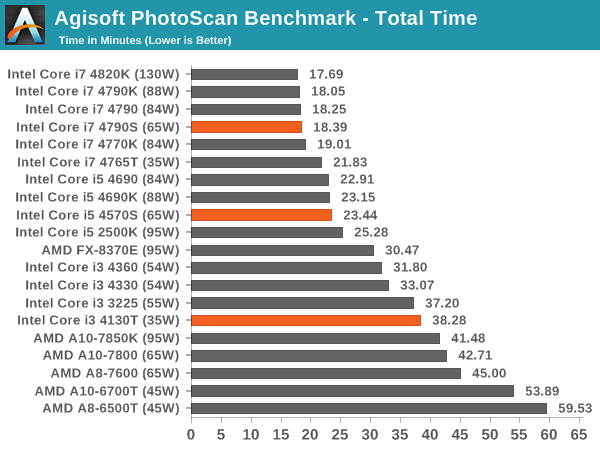
Cinebench R15

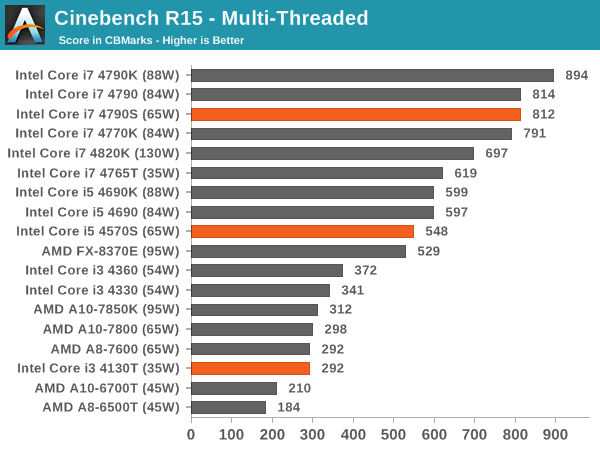
Professional Performance: Linux
Built around several freely available benchmarks for Linux, Linux-Bench is a project spearheaded by Patrick at ServeTheHome to streamline about a dozen of these tests in a single neat package run via a set of three commands using an Ubuntu 14.04 LiveCD. These tests include fluid dynamics used by NASA, ray-tracing, molecular modeling, and a scalable data structure server for web deployments. We run Linux-Bench and have chosen to report a select few of the tests that rely on CPU and DRAM speed.
C-Ray: link
C-Ray is a simple ray-tracing program that focuses almost exclusively on processor performance rather than DRAM access. The test in Linux-Bench renders a heavy complex scene offering a large scalable scenario.
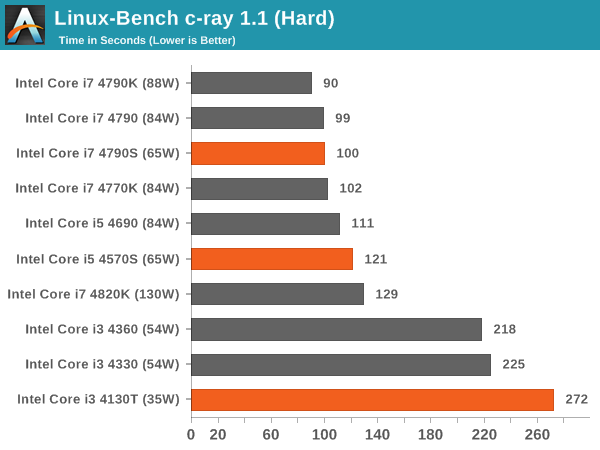
NAMD, Scalable Molecular Dynamics: link
Developed by the Theoretical and Computational Biophysics Group at the University of Illinois at Urbana-Champaign, NAMD is a set of parallel molecular dynamics codes for extreme parallelization up to and beyond 200,000 cores. The reference paper detailing NAMD has over 4000 citations, and our testing runs a small simulation where the calculation steps per unit time is the output vector.
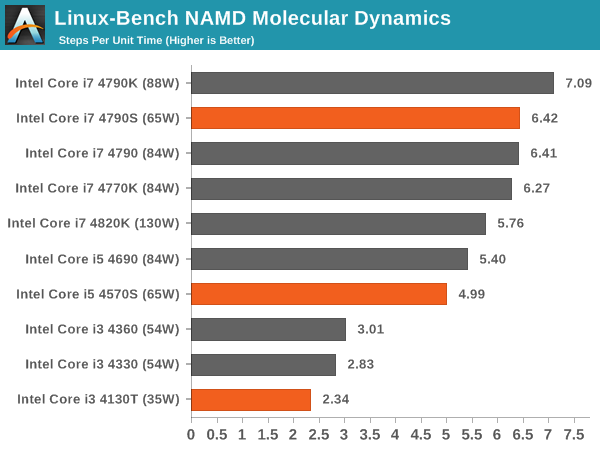
NPB, Fluid Dynamics: link
Aside from LINPACK, there are many other ways to benchmark supercomputers in terms of how effective they are for various types of mathematical processes. The NAS Parallel Benchmarks (NPB) are a set of small programs originally designed for NASA to test their supercomputers in terms of fluid dynamics simulations, useful for airflow reactions and design.
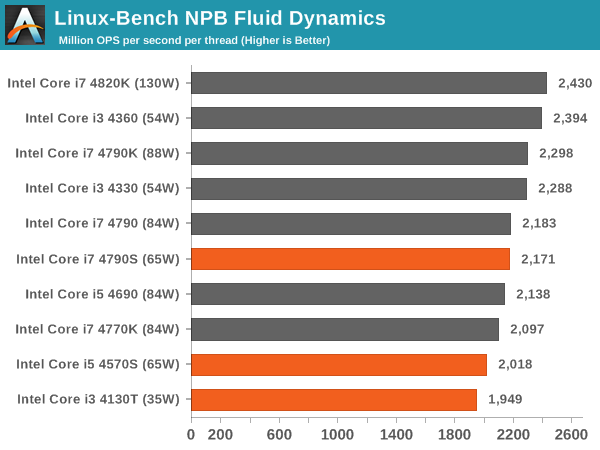
Redis: link
Many of the online applications rely on key-value caches and data structure servers to operate. Redis is an open-source, scalable web technology with a b developer base, but also relies heavily on memory bandwidth as well as CPU performance.
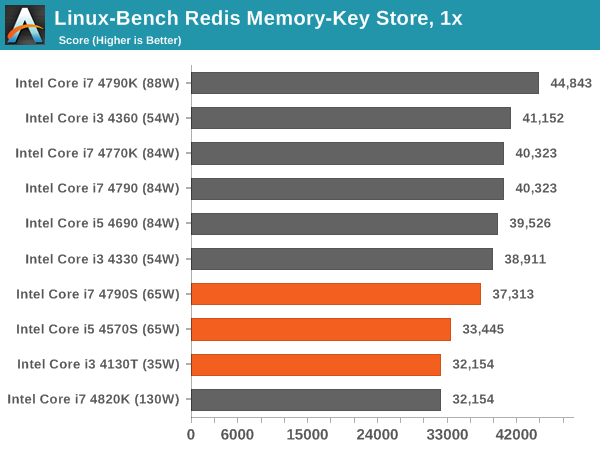
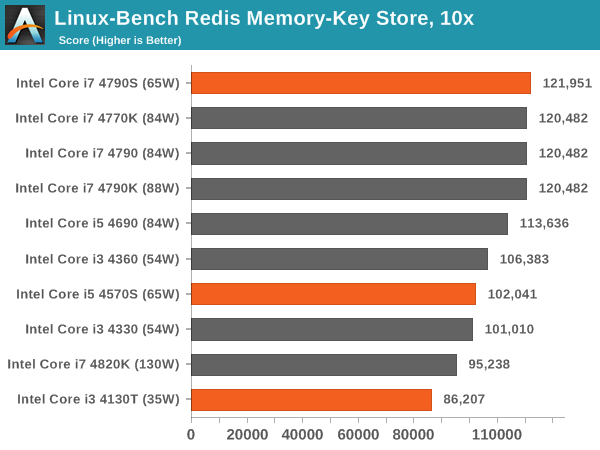











76 Comments
View All Comments
Wolfpup - Friday, December 12, 2014 - link
I'm actually looking at an HP all in one (for a kitchen computer) that has an S series CPU, and was wondering what the heck it was.35 watts for a dual core Haswell @ at least 2.9GHz is actually really impressive when you think about it. I still can't help but compare everything to my 125-watt single core 3.4GHz Prescott from ten years ago. That's a ton more performance crammed in to about 1/4 the power :) Also seems like the 35 watt parts are basically like the normal mobile parts are (before low end systems switched from 35 and 45 watt cpus to 15-19 watt ULV CPUs practically across the board)
samer1970 - Saturday, December 13, 2014 - link
Hello,can you please run the benchmarks again for the xeons with HT disabled? i want to see how the 65Watts 12 cores compares to the 6 cores i7 with hyperthreading disabled on the 12 cores one.
that is 12 cores xeon at 1.8 ht disabled versus 6 cores at 3.6 with ht enabled , which is lolgically 1.8 with ht but at 140w
FYoung - Saturday, December 13, 2014 - link
It would be beneficial to Anandtech and its readers to edit articles like this more closely. It has multiple instances of confusing wording and wordiness.I mean this as constructive criticism in case it escaped your attention, in the hope that Anandtech will not let its standards slip.
LoneWolf15 - Sunday, December 14, 2014 - link
For future articles like this, can you post the integrated graphics? It can be crucial to people building an HTPC.LoneWolf15 - Sunday, December 14, 2014 - link
Clarification: can you post the model of IGP (4400,4600) in your charts? This can be very useful for someone who is saving power by not having a discrete GPU but wants the best Intel offers.coder543 - Sunday, December 21, 2014 - link
I don't know why you're using Linux-Bench. Phoronix Test Suite (PTS) is *the* well-established benchmark suite for Linux, and it can test a wide range of applications and synthetic benchmarks in a completely automated fashion.